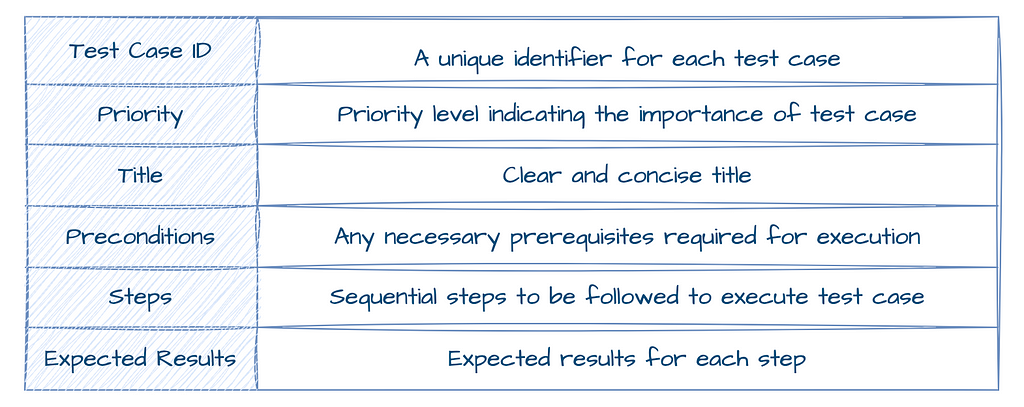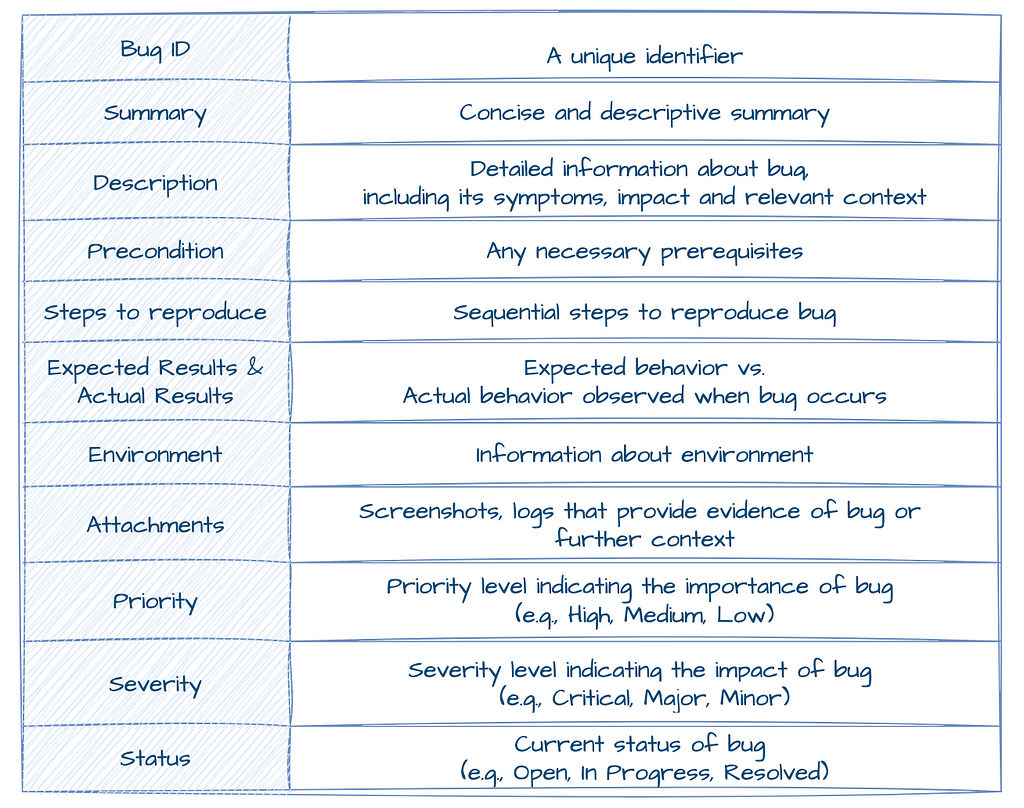
Test Documentation In Software Testing

We’ve already discussed how the success of any project depends on project management processes.
One more aspect that implies the success of projects is test documentation.
Test documentation plays an important role, as it acts as a roadmap, guiding us through the testing process and helping us to uncover potential issues before they impact the end-user.
By paying attention to test documentation, we can significantly improve the quality of our software and deliver results that meet and exceed expectations.
There are different types of test documentation. In this article, I’ll talk about the most common ones:
Test Plan
Test Strategy
Requirements Traceability Matrix
Test Case
Bug Report
Test Results Report
Test Plan
What Is It
Test Plan is a document that describes how testing is organized on the project, outlining the scope, approach, resources, schedule, and deliverables for testing.
ISTQB Glossary Definition
Test Plan is a document describing the scope, approach, resources and schedule of intended test activities. It identifies amongst others test items, the features to be tested, the testing tasks, who will do each task, degree of tester independence, the test environment, the test design techniques and entry and exit criteria to be used, and the rationale for their choice, and any risks requiring contingency planning. It is a record of the test planning process.
Why Is Important
- Clarity: it serves as a roadmap for the testing process, guiding QA engineers and stakeholders on how testing will be conducted to ensure the software meets quality standards.
- Risk management: helps to identify potential risks in testing process, enabling proactive risk mitigation strategies.
- Communication: serves as a communication tool, ensuring that all stakeholders have a shared understanding of testing approach and expectations.
- Resource management: helps in proper planning and allocation of resources.
When Can Be Skipped
For small, straightforward projects where testing activities are well-understood and don’t require extensive planning.
Test Strategy
What Is It
Test Strategy is a document that outlines the overall approach to testing for a project.
It defines the scope of work, testing types and techniques, test levels, environments, tools, etc. to be used.
ISTQB Glossary Definition
Test Strategy is a high-level description of the test levels to be performed and the testing within those levels for an organization or program (one or more projects).
Why Is Important
Test Strategy addresses all the questions on how exactly testing process is performed, by which testing types, and how testing is divided into levels and phases.
When Can Be Skipped
The short answer is never. Test Strategy can be not necessarily a document, but no testing should be done without any strategy. It is important to ensure that testing activities are planned and executed effectively in any case.
Test Plan and Test Strategy are very fundamental artifacts in software testing and deserve a separate article 😊
Requirements Traceability Matrix
What Is It
Requirements Traceability Matrix (RTM) is a document that maps the requirements to corresponding test cases to ensure that all requirements are covered by test cases.
ISTQB Glossary Definition
Traceability Matrix is a two-dimensional table, which correlates two entities (e.g., requirements and test cases). The table allows tracing back and forth the links of one entity to the other, thus enabling the determination of coverage achieved and the assessment of impact of proposed changes.
Why Is Important
- Requirement coverage: RTM ensures that all requirements are covered and will be tested.
- Risk management: in case something is not covered, RTM helps to identify gaps in test coverage and enables proactive Risk Management.
- Change management: RTM facilitates tracking changes in requirements.
When Can Be Skipped
While an RTM can be a valuable tool for ensuring traceability and managing requirements in many projects, its necessity should be evaluated based on factors such as project size, complexity, documentation requirements, and resource constraints.
Attributes
Requirements Traceability Matrix may have a different structure, but in general, it has Requirements listed in the first column and the associated Test Case in the next column. Make sure that each Requirement has at least one Test Case.

Depending on the project needs, it is often helpful to have other columns in Requirements Traceability Matrix to provide additional information:

Test Case
What Is It
Test Case is a set of input data, execution conditions, and expected results designed to verify whether a particular aspect of the software functions correctly.
ISTQB Glossary Definition
Test Case is a set of input values, execution preconditions, expected results and execution postconditions, developed for a particular objective or test condition, such as to exercise a particular program path or to verify compliance with a specific requirement.
Why Is Important
Test cases are needed for several reasons:
- Improve requirements quality: discover unclarity, ambiguity, and inconsistency in requirements, that will be addressed and resolved.
- Requirements verification: test cases ensure that software meets the specified requirements by validating each functionality or feature against the defined criteria.
- Systematization: test cases help to structure and systematize the approach to testing.
- Test Coverage: test cases are the main source of information for test coverage.
- Documentation: store information, use them for new team members onboarding, and clarify understanding between stakeholders.
- Regression testing: test cases serve as a baseline for conducting regression testing.
When Can Be Skipped
Testing can be conducted with different levels of formality: from highly formal (with extensive detailed documentation) to very informal (may have no documentation at all or notes kept by individual testers).
The right level of formality depends on the context:
- complexity of the project
- timelines/time constraints
- requirements quality
- long-term project with multiple releases or an application to be used by only a few people for a short time
- organizational culture and maturity
Generally, it’s a good practice to have documentation. Instead of test cases, a more high-level approach may involve using Checklists with notes of what is intended to be tested and the expected results.
Attributes
Test Case attributes depend on Test Case Management Tool and may have a bit different fields, but typically have the following structure:

Bug Report
What Is It
During test execution testers are looking for bugs. Once the bug is found, it should be reported as Bug Report.
Bug Report is a detailed document that describes an issue or defect encountered in software during testing or usage. It typically includes such information as bug description, steps to reproduce, expected and actual results, and any relevant attachments or screenshots.
ISTQB Glossary Definition
Bug Report is a document reporting on any flaw in a component or system that can cause the component or system to fail to perform its required function.
Why Is Important
Bug Report is needed for several reasons:
- Provides information about the identified issue, enabling developers to understand, reproduce, and fix it.
- Acts as a heads-up for the project team that attention is needed.
- Serves as a historical record of software defects, helping to track and prioritize bug fixes throughout the development lifecycle.
- In an ideal case provides root cause analysis of the problem and recommendations for further steps.
When Can Be Skipped
Bug reports should ideally never be skipped, as they play a critical role in ensuring software quality.
In some rare cases, when the issue can be fixed sooner than reported, or already documented elsewhere, skipping the formal bug report process may be acceptable. However, it’s important to consider the potential impact of skipping bug reports on overall quality assurance efforts.
Attributes
Bug Report attributes depend on Bug Management Tool and may have a bit different fields, but typically has the following structure:

Test Result Report
What Is It
Test Result Report (also called Test Status Report, Test Progress Report, Test Summary Report) is a document that provides an overview of the current status of testing activities, results, and findings.
It includes information on the progress of test execution, the status of test cases, identified defects, and any other relevant testing metrics, that are needed in decision-making.
ISTQB Glossary Definition
Test Status Report is s document summarizing testing activities and results, produced at regular intervals, to report progress of testing activities against a baseline (such as the original test plan) and to communicate risks and alternatives requiring a decision to management.
Why Is Important
- Enables transparency by documenting testing progress, found issues, and planned actions.
- Provides stakeholders with information about software quality.
- Helps with informed decision-making (e.g. release readiness, resource allocation, risk mitigation strategies).
When Can Be Skipped
- For small projects with limited testing scope and duration.
- In agile projects with frequent iterations and continuous feedback loops, where testing progress is transparent and regularly discussed in daily stand-ups or sprint reviews.
- In situations with severe time constraints when resources need to be focused solely on testing activities.
To summarise, creating Test Documentation in general has the following Advantages and Disadvantages:
Advantages of Test Documentation
- Reduce unclearness, uncertainty, and ambiguity about testing activities.
- Provides a structured approach to software testing.
- Helps you to improve transparency among project stakeholders.
- Serves as educational material for newcomers.
- Facilitates delivery of a high-quality product to the client within designated timelines.
Disadvantages of Test Documentation
- Time-consuming to create and keep up-to-date.
- In some cases, time and effort invested in creating documentation may outweigh its value.
- Poor documentation may lead to misunderstandings and impact product quality.
Conclusions
Each of these documents serves its specific goal in testing, but their importance and scope can vary depending on project size, complexity, and methodology.
It’s important to find a balance between documentation overhead and the need for clear communication and traceability.
